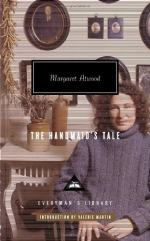|
This section contains 1,253 words (approx. 5 pages at 300 words per page) |

|
The Power of Language in A Handmaid's Tale
Summary: Explores the use of descriptive language in "A Handmaid's Tale," by Margaret Atwood. Describes how language of "The Handmaid's tale," is at once accessible and inaccessible. The vocabulary, syntax and semantics are modern and familiar, making the language appear deceptively easy.
Gilead is a highly stratified and ritualised society, where the individual is tightly controlled by the totalitarian regime. Through Gilead Atwood presents us with a system that makes clever use of the written word through heavy restrictions and by doing she demonstrates the power of language in whatever form.
Once the state of Gilead is set up the men soon realise the power of the written word and the ways in which they can use it as an effective form of control for the women of Gilead. Therefore the written word is outlawed, for Handmaid's even opportunities to talk other than I prescribed greetings and phrases:" blessed be the fruit," are limited and often closely monitored. Gilead is of course a theocracy and so therefore its official vocabulary incorporates religious terminology and biblical references. Domestic servants are called "Marthas" in reference to a domestic character in the New...
|
This section contains 1,253 words (approx. 5 pages at 300 words per page) |

|


